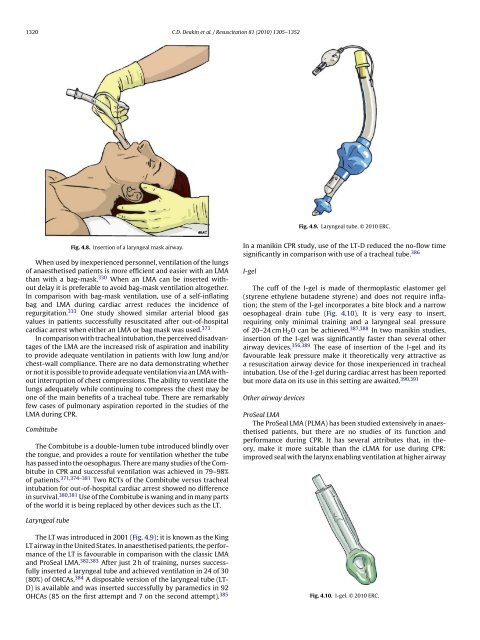European Resuscitation Council Guidelines for Resuscitation 2010 ...
European Resuscitation Council Guidelines for Resuscitation 2010 ...
European Resuscitation Council Guidelines for Resuscitation 2010 ...
You also want an ePaper? Increase the reach of your titles
YUMPU automatically turns print PDFs into web optimized ePapers that Google loves.
1320 C.D. Deakin et al. / <strong>Resuscitation</strong> 81 (<strong>2010</strong>) 1305–1352<br />
Fig. 4.9. Laryngeal tube. © <strong>2010</strong> ERC.<br />
Fig. 4.8. Insertion of a laryngeal mask airway.<br />
When used by inexperienced personnel, ventilation of the lungs<br />
of anaesthetised patients is more efficient and easier with an LMA<br />
than with a bag-mask. 330 When an LMA can be inserted without<br />
delay it is preferable to avoid bag-mask ventilation altogether.<br />
In comparison with bag-mask ventilation, use of a self-inflating<br />
bag and LMA during cardiac arrest reduces the incidence of<br />
regurgitation. 333 One study showed similar arterial blood gas<br />
values in patients successfully resuscitated after out-of-hospital<br />
cardiac arrest when either an LMA or bag mask was used. 373<br />
In comparison with tracheal intubation, the perceived disadvantages<br />
of the LMA are the increased risk of aspiration and inability<br />
to provide adequate ventilation in patients with low lung and/or<br />
chest-wall compliance. There are no data demonstrating whether<br />
or not it is possible to provide adequate ventilation via an LMA without<br />
interruption of chest compressions. The ability to ventilate the<br />
lungs adequately while continuing to compress the chest may be<br />
one of the main benefits of a tracheal tube. There are remarkably<br />
few cases of pulmonary aspiration reported in the studies of the<br />
LMA during CPR.<br />
Combitube<br />
The Combitube is a double-lumen tube introduced blindly over<br />
the tongue, and provides a route <strong>for</strong> ventilation whether the tube<br />
has passed into the oesophagus. There are many studies of the Combitube<br />
in CPR and successful ventilation was achieved in 79–98%<br />
of patients. 371,374–381 Two RCTs of the Combitube versus tracheal<br />
intubation <strong>for</strong> out-of-hospital cardiac arrest showed no difference<br />
in survival. 380,381 Use of the Combitube is waning and in many parts<br />
of the world it is being replaced by other devices such as the LT.<br />
In a manikin CPR study, use of the LT-D reduced the no-flow time<br />
significantly in comparison with use of a tracheal tube. 386<br />
I-gel<br />
The cuff of the I-gel is made of thermoplastic elastomer gel<br />
(styrene ethylene butadene styrene) and does not require inflation;<br />
the stem of the I-gel incorporates a bite block and a narrow<br />
oesophageal drain tube (Fig. 4.10). It is very easy to insert,<br />
requiring only minimal training and a laryngeal seal pressure<br />
of 20–24 cm H 2 O can be achieved. 387,388 In two manikin studies,<br />
insertion of the I-gel was significantly faster than several other<br />
airway devices. 356,389 The ease of insertion of the I-gel and its<br />
favourable leak pressure make it theoretically very attractive as<br />
a resuscitation airway device <strong>for</strong> those inexperienced in tracheal<br />
intubation. Use of the I-gel during cardiac arrest has been reported<br />
but more data on its use in this setting are awaited. 390,391<br />
Other airway devices<br />
ProSeal LMA<br />
The ProSeal LMA (PLMA) has been studied extensively in anaesthetised<br />
patients, but there are no studies of its function and<br />
per<strong>for</strong>mance during CPR. It has several attributes that, in theory,<br />
make it more suitable than the cLMA <strong>for</strong> use during CPR:<br />
improved seal with the larynx enabling ventilation at higher airway<br />
Laryngeal tube<br />
The LT was introduced in 2001 (Fig. 4.9); it is known as the King<br />
LT airway in the United States. In anaesthetised patients, the per<strong>for</strong>mance<br />
of the LT is favourable in comparison with the classic LMA<br />
and ProSeal LMA. 382,383 After just 2 h of training, nurses successfully<br />
inserted a laryngeal tube and achieved ventilation in 24 of 30<br />
(80%) of OHCAs. 384 A disposable version of the laryngeal tube (LT-<br />
D) is available and was inserted successfully by paramedics in 92<br />
OHCAs (85 on the first attempt and 7 on the second attempt). 385<br />
Fig. 4.10. I-gel. © <strong>2010</strong> ERC.
















